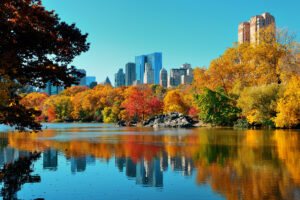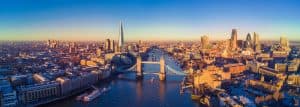
5 Benefits of Blue Spaces in Urban Areas
By Beth Rush
Blue spaces — the water-rich areas in urban settings — are more than just aesthetic elements. They enhance the quality of life in cities. These spaces offer a serene escape from the urban hustle, contributing significantly to environmental health and the well-being of city dwellers.
Their importance in urban areas is paramount, as they bring a slice of nature into concrete landscapes, improving mental and physical health and fostering community connections.
What Are Blue Spaces in Urban Areas?
Blue spaces refer to natural or artificial bodies of water within urban environments. These spaces range from rivers, lakes, and canals to fountains, ponds, and reservoirs. A vital characteristic of blue spaces is their ability to blend seamlessly into the cityscape, offering aesthetic beauty and functional benefits.

These spaces are often focal points for recreation and relaxation, providing an essential connection to nature amidst urban settings.
For instance, the serene beauty of natural rivers — like the Seine in Paris or the Thames in London — offers a visual spectacle and a recreational hub.
On the other hand, artificial features — like the reflecting pools in Washington D.C. or the picturesque canals in Amsterdam demonstrate how urban planning can incorporate water to enhance city life.
Benefits of Blue Spaces
Blue spaces in urban areas are vital for the health and well-being of city residents. Here are the various benefits these water-rich environments offer, from enhancing mental health to boosting local economies.
- Physical Health Boost
Blue spaces in urban environments are catalysts for physical health. These aquatic features naturally encourage activities — like swimming, kayaking, and leisurely walks along the water’s edge — promoting regular exercise among city dwellers.
Even water immersion has immediate health benefits, such as decreased blood pressure. This phenomenon illustrates how blue spaces can offer direct physiological benefits, making them essential for a healthier urban lifestyle.
- Social and Community Benefits
Blue spaces are natural gathering spots, fostering community and inclusivity. These areas provide a common ground where people from diverse backgrounds come together, whether for leisure activities, community events or to enjoy the tranquil environment.
The presence of water creates a welcoming and relaxed atmosphere, encouraging social interactions and building connections among residents. This inclusivity strengthens community bonds and enriches the city’s social fabric, making blue spaces vital for fostering a sense of belonging in urban settings.
- Mental Health Improvement
These spaces also reduce stress and enhance mental well-being. The calming effect of water, whether the gentle flow of a river or the serene stillness of a lake, provides a peaceful escape from the fast-paced urban environment.
Numerous studies have shown that spending time in outdoor blue spaces positively influences mental health, significantly reducing stress levels and improving well-being. This natural affinity for water soothes the mind and encourages a healthier, more balanced lifestyle, emphasizing the importance of blue spaces in nurturing mental health in cities.
- Economic Advantages
Blue spaces in urban areas are not just beneficial for residents’ well-being — they also have a tangible economic impact. Properties near these water-rich environments often increase in value, as the allure of scenic water views and access to recreational activities makes them highly sought after.
Additionally, these spaces are significant tourism magnets, attracting visitors eager to experience the unique blend of nature and urban life. This influx of tourists supports local businesses and contributes to the area’s economic vitality, showcasing how blue spaces are visually appealing and financially advantageous for cities.
- Environmental Impact
Bodies of water in urban areas contribute to ecological health. These are vital habitats for diverse wildlife, promoting biodiversity in a predominantly concrete landscape. Various water bodies support different species of birds, fish, and aquatic plants, fostering a rich and balanced ecosystem.
Moreover, blue spaces improve air quality. Water bodies naturally help filter pollutants and reduce air pollution. They also moderate urban temperatures, countering the heat island effect commonly found in cities.
Challenges and Solutions
Implementing blue spaces in urban areas faces several challenges, such as limited space, environmental degradation, and budget constraints. Urban planners must navigate the intricate balance between development and maintaining natural landscapes. Additionally, pollution and ecological neglect can degrade existing blue spaces, making them less beneficial and harmful to the community.
Innovative and sustainable urban planning is essential to overcome these challenges. Solutions include creating multi-functional blue spaces that combine recreation, flood management, and ecological habitats.
Investing in green infrastructure — like rain gardens and permeable pavements — also enhances the effectiveness of blue spaces. Restoration projects focused on cleaning and revitalizing these spaces are crucial for polluted areas. Cities can successfully integrate and preserve valuable blue spaces by adopting a holistic approach considering environmental, social, and economic factors.
Advocating for More Blue Spaces in Cities
Blue spaces in urban areas offer various benefits for its residents, from improving mental and physical health to boosting the local economy and enhancing ecological diversity. Community members must advocate for creating and maintaining these vital spaces.
You can influence the development of more blue city spaces by voicing your support to local representatives and participating in community planning meetings. Together, people can champion the significance of these areas and work towards creating more vibrant, healthy, and sustainable urban environments.
About the Author: Beth Rush is the green wellness editor at Body+Mind. She has more than five years of experience writing and editing articles covering topics like sustainable transit and the importance of green spaces in urban planning. You can find Beth on Twitter @bodymindmag.
Subscribe to Body+Mind for more posts by Beth!